This is a guest post from Nate Desmond of SumoMe, plus half a dozen contributors you’ll encounter throughout the article.
Too many blogs are plagued by hit-and-run visitors. These are people who come, read your article, and then melt back into the ether of the internet.
As much as we love to see spikes in our website visitor analytics, post views are actually useless. Unless those visitors do something – buy your course, follow you on Twitter, join your email list – even a large traffic spike will leave you back in the same place a few days later.
So how can you transform one-time visitors into lifelong readers?
Simple: convince them to join your email list.
Next time you publish a new post, you won’t start over from zero – your new email subscribers will be glad to read your latest writing. Think of it as a great vicious cycle. More emails = more traffic = more sharing = more emails.
But how do you build your email list?
 I wondered the same thing, so I asked major bloggers for their advice. Here’s what they said:
I wondered the same thing, so I asked major bloggers for their advice. Here’s what they said:
#1. Partner with other bloggers
“Strategic alliances help grow the email list. The clients already know and trust the partner and hence the trust is transferred to us as well.”
– Sean Dsouza writes at Psychotactics
Partnerships with other bloggers can help both blogs reach new audiences and build their reach. When selecting potential alliances, look for two factors:
1. Size: While bigger blogs offer bigger rewards, they also are less likely to be interested.
2. Audience: The more similar your audiences are, the more benefit both blogs will see.
Keeping these criteria in mind, build a list of 10-20 blogs you’d potentially like to partner with.
Here’s an example guest post on ProBlogger
Once you’ve selected a these potentials, decide what type of content you’d like to use:
- Webinar
- Guest post
- Ebook
- Podcast
- Physical events
Armed with these ideas, you’re ready to reach out to the bloggers you brainstormed earlier. Particularly when you’re new and don’t know people, this step will often be discouraging as probably only one in 10 bloggers will express any interest.
Instead of becoming frustrated, expect initial failure, and use the results to steadily improve your emails. As you start gaining momentum after your first partnership, landing the second and third will be easier.
#2. Prominently ask people to subscribe – then provide amazing value
“A big-ass banner across the top of my blog helped a lot. I also used CrazyEgg.com to make sure people were clicking on it. I went through a couple of revisions based on the CrazyEgg stats.
At first I was afraid of asking for people’s emails because I thought it would annoy them. Then I realized getting my posts via email were people’s favorite way of hearing from me!
Once someone joins my email list, I use Aweber to automatically send a series of epically valuable emails over the next couple of weeks. This helps transform a new subscriber into a hardcore, engaged fan.”
– Neville Medhora writes at Neville’s Financial Blog
Rather than just sticking a form randomly on your site and hoping for the best, take the time to test the best placement, wording, and coloring like Neville did.
You should test many elements of your form:
- Headline
- Button text
- Forms required (name and email or just email?)
- Color
- Incentive
The signup incentive is a particularly potent piece of your form. Here are some ideas to consider:
- Ebooks
- Recordings
- Cheatsheets
- Videos
- Email series
One of the incentives Neville uses to build his email list
Optimizing form locations and incentives will help you get many times more email subscribers than you do right now. Just remember, getting email signups is only the very beginning of a strong reader relationship.
This reader trusts you enough to share their email address – now it’s your turn to prove you’re worthy of it. Work to consistently overdeliver on expectations, and you’ll soon have a thriving email following!
#3. Use a non-annoying popover
“When I first started my latest blog, I just slapped a basic subscription form somewhere on my sidebar. Barely anyone noticed it, and even fewer subscribed.
Then I tried SumoMe’s List Builder plugin. Literally overnight, I saw a 10x increase in subscriber conversion, and my list has continued growing steadily ever since.
I actually liked it so much that I now work for the company!”
– Nate Desmond writes at NateDesmond.com and SumoMe
Building an email list is one of the fastest ways to compound your blog’s growth, so you’ll want to start optimizing your email forms as soon as you get the first trickle of traffic.
This is the email popover I use on my blog
For me, SumoMe popovers have been the most successful effort thus far. They’re pretty simple to setup (took me less than 5 minutes), but you should watch for a couple things:
- Timing – Mine loads after about 1 second, but you should experiment to see what works best for your website.
- Color – Make sure your form is colored similarly to your website – context matters.
- Wording – This is critical. Brainstorm 25 ideas for headlines and test the three best.
Forms in your sidebar, footer, or even header can be out of your reader’s line-of-sight, so non-annoying popovers can be a highly effective way to get your reader’s attention.
 #4. Produce exceptional content
#4. Produce exceptional content
“Producing exceptional content that our readers can use to improve their craft.”
– Sean Work writes at KISSmetrics
Ultimately, the success of your blog relies on the quality of your writing. A strong email list can help speed your growth, but everything ultimately relies on your posts and emails providing stunning content that solves real problems for your readers.
Quality content attracts potential readers to your website and inspires current subscribers to stick around and engage.
This is part of an infographic KISSmetrics uses to engage
Here are a few things you can do to make your writing amazing:
Write articles that you would want to read and share with your friends, and you’ll probably be off to a strong start.
#5. Use Post-Specific Bonus Content
“Giveaway a bonus within your content that requires the readers email address.
Think of it like Facebook advertising.
My click-through-rate (ctr) on the newsfeed ads is 2.5% while my sidebar Facebook ads on a great day do .5% ctr.
That’s a 500% increase in clicks.
 People are engaged in the middle of the site, NOT on the fringes.
People are engaged in the middle of the site, NOT on the fringes.
Think of this with email collection within your blog.
Make a benefit and give the reader a link / button to get a cheat-sheet or bonus document related to the content the person is reading.
Then ask them for an email to get that content.
If you are really lazy just do it for the top 3 posts you get traffic on.
I have seen this nearly increase my daily email growth by 30%!”
– Noah Kagan runs SumoMe and writes at Okdork
Advertising platforms like Facebook are working tirelessly to try to better understand visitor intent. The more they can tailor advertisements to what a person actually wants; the more customers they will see.
You have a major advantage over advertisers though – since your visitor is reading a specific post, you already know that they have at least some interest in the post’s topic.
Based on this knowledge, you can create a targeted call-to-action offering exclusive content that builds on your post.
This email bonus is from one of Noah’s recent posts
So what exactly can you offer?
- Google spreadsheets with exact formulas
- PDF “cheatsheets” with a quick review of your post
- Video materials adding on to your post
- Exact emails and scripts you’ve used in your case studies
- Ebooks closely related to the post topic
- “Inside tips” like the list of top giveaway sites in the above example
Whatever you choose, giveaway incredible value and you’ll not only get email subscribers – you’ll get lifelong readers!
#6. Use multiple signup forms
“The number one strategy that helped me grow my list was placing multiple sign up forms on high traffic pages on my site and offering a high value giveaway in return.
Today I have forms in my popup, in my sidebar, at the bottom of every post and on a slide in.”
– Steve Chou writes at MyWifeQuitHerJob.com
Different readers will be ready to subscribe at different times. If you have a subscription form ready when they want to subscribe, your email list will grow quickly.
You should test email signup forms in all these locations:
Steve’s got a great sidebar form on his site
Over time, you’ll probably find two or three forms are dramatically more effective than the others. At that point, you can remove the low performers and focus on optimizing the forms that do work to make them even better.
This is a principle that actually applies in all areas of blog growth – cut the strategies that don’t work and double-down on the areas that are showing results.
#7. Provide deep research that solves problems
“There has to be a steady stream of high quality content that actually solves the visitor’s problem.
There’s a lot of research that goes into the articles we publish, because too many of the marketing articles out there skate by passing opinion off as fact without any kind of qualification. The problem with that is that it creates a culture of “marketers” who blindly follow opinion without being willing to test that on their own.
By including the deep research, and really digging to find those “aha” moment, we try to create a “can’t miss” experience.
The feeling is that if you don’t sign up for email, you might miss something valuable that increases your revenue. Nobody wants to miss out on revenue, especially if learning how to get more of it will be sent to your inbox for free.”
– Tommy Walker is the editor of ConversionXL
Most blogs today fall into one of two main categories: “churn and burn” websites that just publish frequent, basic posts and long-form websites that publish detailed, researched posts. Both types of content can build popular blogs, but in today’s competitive blogosphere you’ll generally go farther and faster with long-form content.
How can you do this?
It’s actually not nearly as complicated as you might think.
First, litter your posts with fun, memorable stories. Some authors actually go so far as keeping a “commonplace book” filled with stories waiting to be used. Others simply write from memory. Either way, adding examples and stories to your posts will make them easier to read and more helpful.
Second, use lots of statistics in your posts (and also in your headlines!). Lots of posts can tell you that colorful images are more popular on Pinterest, but that’s not nearly as useful as knowing that colorful images get 300% more shares.
One of many specific case studies shared on ConversionXL
As you write your blog posts and emails, look for opportunities to share unique, actionable information that will make your readers think “ah ha!”… and hopefully subscribe to your email list.
#8. Place a giant lead magnet on your blog homepage
“For the last six months or so we’ve been displaying a “lead magnet” on our blog homepage that offers four ecommerce case studies that  drip out via autoresponder. After subscribers get the content they’re added to our main blog list.
drip out via autoresponder. After subscribers get the content they’re added to our main blog list.
Note: we aren’t currently using this on the blog as we plan to deploy it somewhere else soon.”
– Mark Macdonald writes at Shopify
What’s the most visited page on your website?
You guessed it… your homepage!
Unfortunately, your default homepage is also probably the least engaging page on your entire website. You’ve probably got a random array of your most recent posts, maybe a few images, and some sort of a sidebar.
Adding a major email form with a high-value incentive can help you transform confused visitors into engaged readers.
Shopify’s homepage subscription box
By filling most of the above-the-fold space on the blog homepage, this email box is almost as effective as a popover at drawing attention. The images and growth graph both make the form visually engaging, and who wouldn’t want to get 4 free case studies?
Unless you have a coding background, this could seem difficult to build. Never fear! You can simply use this plugin to make something very similar on your own website.
#9. Persistently continue writing – growth compounds
“The number one thing that helped me grow my email list was persistence. I have been writing a blog for ten years, and working really hard and teaching myself to write posts that people love. When you write good content, the email list is easy.”
– Penelope Trunk writes at PenelopeTrunk.com and Quistic
Here’s the fun thing about growing your blog: moving from 3,000 to 4,000 subscribers will be just about as hard as getting your first 100 subscribers. Growth compounds.
One of the most important keys to blogging is actually quite simple: keep writing and keep improving.
I always love Babe Ruth’s quote: “It’s hard to beat a person who never gives up.”
Generally, growth will be very slow for the first month or two; then it will start to accelerate for the next few months, and you’ll start to feel like you’re on fire after about seven months.
Practice clicking this button frequently
Unfortunately, the vast majority of writers quit before they reach the tipping point. If you just keep steadily writing, your email list will grow faster and faster.
What single thing has been most effective in building your email list?
Nate Desmond works at SumoMe helping fellow bloggers build their email lists, increase social shares, and build thriving blog communities though a suite of growth tools.
Originally at: Blog Tips at ProBlogger
9 World-class Bloggers Share Their #1 Email List Building Tip










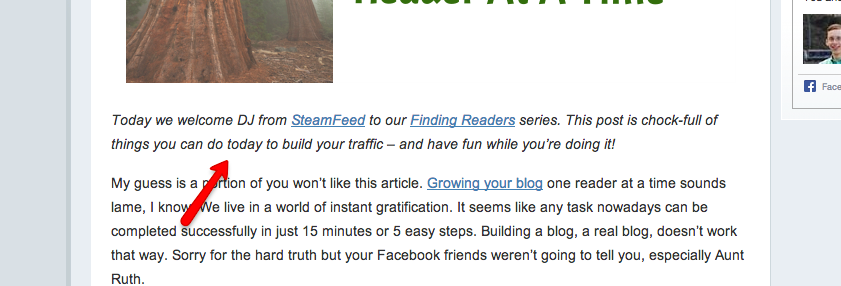
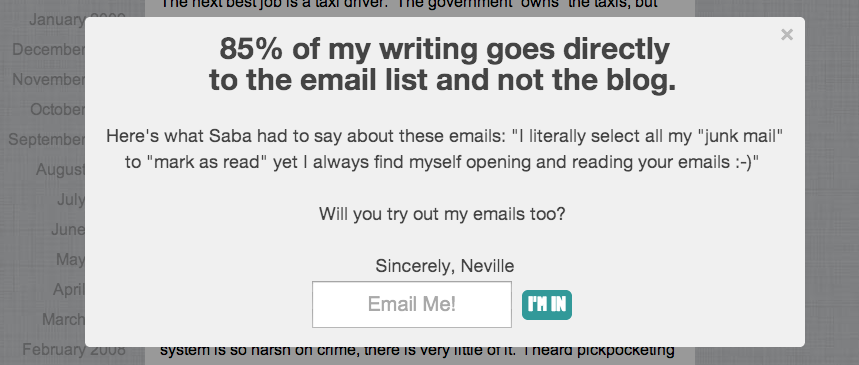
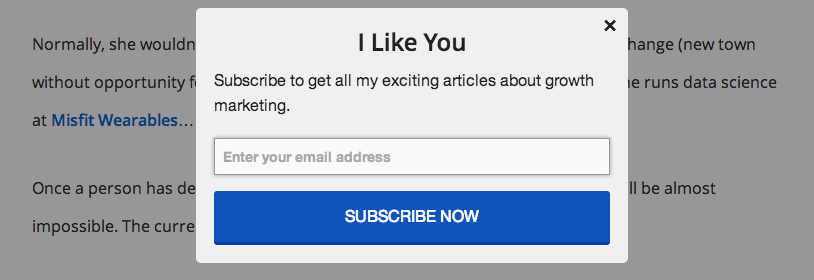

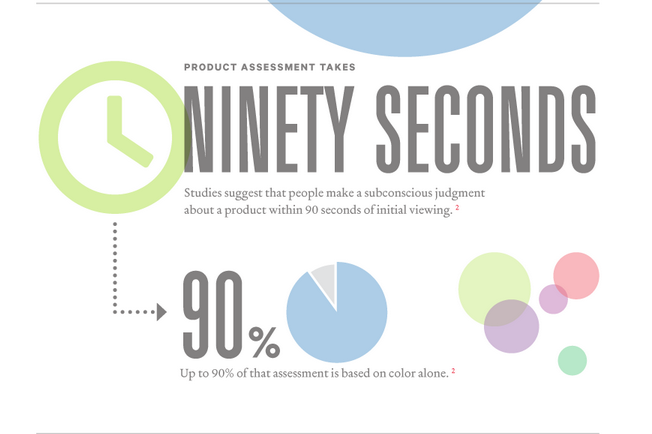
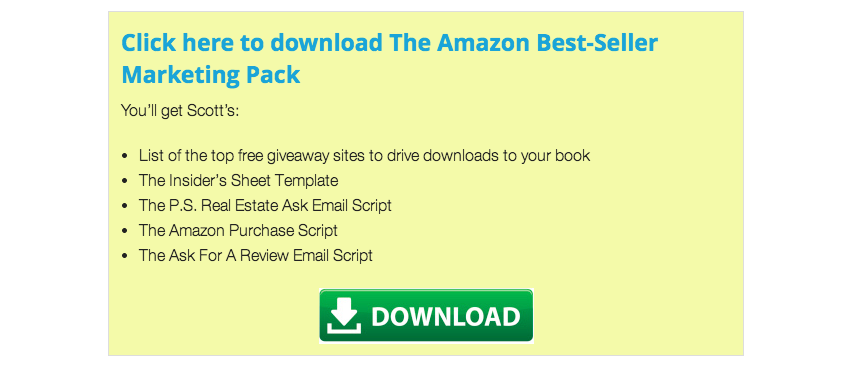

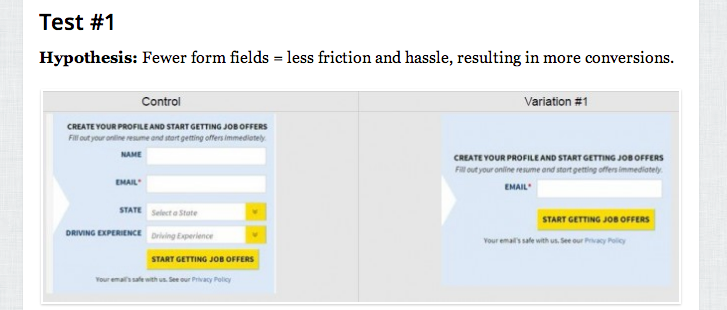

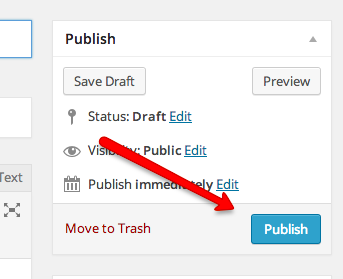






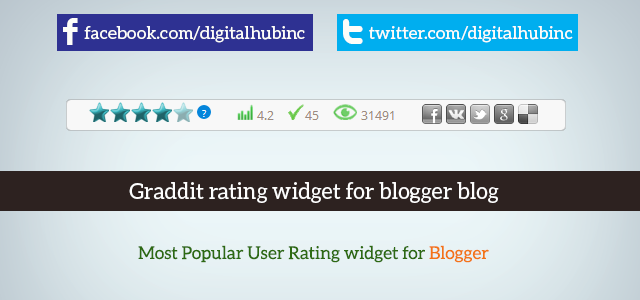








No Comments